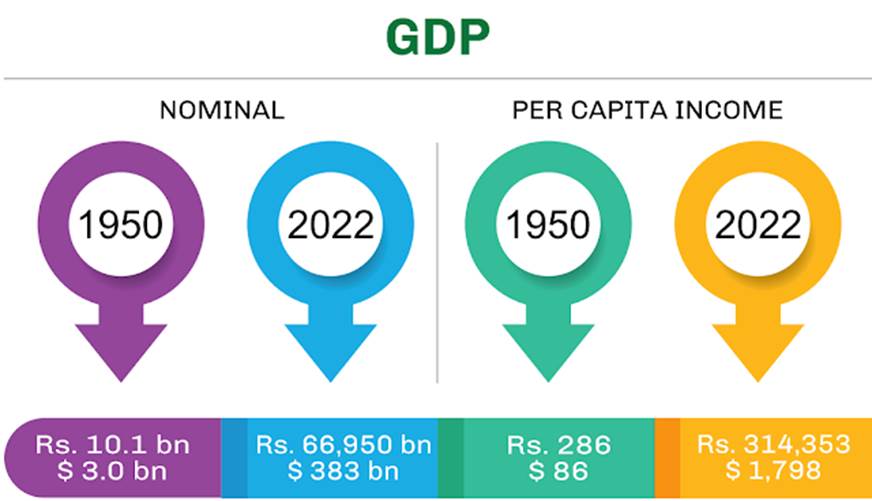Pakistan at 75: Highlights of Economic and Demographic Progress since Independence
By Riaz Haq
CA

Pakistan is a young nation with a lot of unrealized potential. As the country turned 75, it is important to recognize that all basic indicators of progress such as income, employment, education, health, nutrition, electricity use, telecommunications and transportation have shown significant improvements over the last seven and a half decades.
These improvements can be accelerated if Pakistan can overcome its economic growth constraints from recurring balance of payments crises such as the one the country is experiencing now. The only way to do this is through rapid expansion of exports and major reduction in reliance on imports such as fossil fuels and cooking oil .
Income/GDP Growth
The Economic Survey of Pakistan 2021-22 confirms that the nation's GDP grew nearly 6% in fiscal year 2021-22, reaching $1.62 trillion in terms of purchasing power parity (PPP). It first crossed the trillion-dollar mark in 2017. In nominal US$ terms, the size of Pakistan's economy is now $383 billion. The country's per capita income is $1,798 in nominal terms and $7,551 in PPP dollars.

|
Pakistan GDP, per capita income growth - 75 years economic journey |
Electricity Consumption
Pakistan's electricity consumption is an important indicator of economic activity and living standards. It has soared from 40 GWH in 1949 (1 KWH per capita) to 136,572 in 2021 (620 KWH per capita). Last year, hydroelectric dams contributed 37,689 GWH of electricity or 27.6% of the total power generated, making hydropower the biggest contributor to power generation in the country. It was followed by coal (20%), LNG (19%) and nuclear (11.4%). Nuclear power plants generated 15,540 GWH of electricity in 2021, a jump of 66% over 2020. Overall, Pakistan's power plants produced 136,572 GWH of power in 2021, an increase of 10.6% over 2020, indicating a robust economic recovery amid the COVID19 pandemic.
Population Growth
Pakistan's population has grown rapidly over the last 75 years. It is now 227 million, 6.7 times 34 million in 1951. However, the total fertility rate has declined from 6.5 babies in 1950 to 3.3 babies per woman in 2021.
Life Expectancy
Improvements in access to healthcare have helped raise life expectancy in the country. It has increased from just 50 years in 1970 to 67.4 years in 2020.
Employment
Pakistan's economy has generated tens of millions of jobs since the nation's independence. The employed workforce has grown from 16.24 million in 1963-64 to 67.25 million in 2020-21, according to government sources . Pakistan has created 5.5 million jobs during the past three years – 1.84 million jobs a year, significantly higher than the yearly average of new jobs created during the 2008-18 decade, according to the findings of the Labor Force Survey (LFS) reported by the Express Tribune paper . The biggest jump in share of employment (1.5%) was in the construction sector, spurred by Naya Pakistan construction incentives offered by the PTI government.

|
Pakistan employment growth |
|
Unlike Pakistan's, India's labor participation rate (LPR) has been falling significantly in the last decade. It fell to 39.5% in March 2022, as reported by the Center for Monitoring Indian Economy (CMIE). It dropped below the 39.9% participation rate recorded in February. It is also lower than that witnessed during the second wave of Covid-19 in April-June 2021. The lowest the labor participation rate had fallen to in the second wave was in June 2021 when it fell to 39.6%. The average LPR during April-June 2021 was 40%. March 2022, with no Covid-19 wave and with much lesser restrictions on mobility, has reported a worse LPR of 39.5%.
Youth unemployment for ages 15-24 in India is 24.9%, the highest in the South Asia region. It is 14.8% in Bangladesh and 9.2% in Pakistan, according to the International Labor Organization and the World Bank .
Nutrition
In terms of the impact of economic growth on average Pakistanis, the per capita average daily calorie intake jumped to 2,735 calories in FY 2021-22 from 2,457 calories in 2019-20. It has grown from 2,250 calories in 1980 to 2,780 calories in 2020.

|
Pakistan per capita daily calorie consumption - Economic Surveys of Pakistan |
|
Agriculture
Pakistan experienced broad-based economic growth across all key sectors in FY 21-22; manufacturing posted 9.8% growth, services 6.2% and agriculture 4.4%. The 4.4% growth in agriculture is particularly welcome; it helps reduce rural poverty.

|
Wheat production in Pakistan |

|
Rice production in Pakistan |
|
|

|
Meat production in Pakistan |
|
|
Literacy and Education
Literacy in Pakistan has increased from just 16.4% in 1950-51 to 62.8% in 2020-21. Male literacy is now at 73.4% but female literacy lags behind at only 51.9%. The area of female literacy clearly requires greater attention and focus.

|
Literacy rate in Pakistan |
The number of universities in the country has jumped from just 2 in 1947 to 233 in 2021. Enrollment in these colleges has gone up from 644 in 1947 to 1.96 million in 2021. The biggest increases have come since the higher education reform led by Dr Ata ur Rahman on President Musharraf's watch.

|
University enrollment in Pakistan |
The number of degree colleges in the country has jumped from 40 in 1960 to 3,872 in 2021. Enrollment in these colleges has gone up from 4,368 in 1947 to 758,000 in 2021.

|
Enrollment in degree colleges in Pakistan |
Telecommunications
Telecommunication services and broadband subscriptions in Pakistan have rapidly grown, especially over the last two decades. The number of telephone and mobile users has increased from 15,200 in 1947 to 194.2 million in 2021.

|
Phone users in Pakistan |
Transportation
Expansion of road infrastructure and increasing vehicle ownership have contributed to the growth of the road transport sector . The number of registered vehicles in Pakistan has soared from 31,892 in 1947 to 32.4 million in 2021. Road mileage has gone up from 26,300 km in 1947 to 500,000 km in 2021.

|
Vehicle ownership and road length in Pakistan |
Pakistan has seen significant improvement in the living standards of its population since independence in 1947. The average Pakistani has much higher income and greater access to food, healthcare, education, housing, transport, electricity, and communication services.
Acknowledgement: Charts and data in this blog post are sourced from 75 Years Economic Journey of Pakistan published by Pakistan's Ministry of Finance.
(Riaz Haq is a Silicon Valley-based Pakistani-American analyst and writer. He blogs at www.riazhaq.com )

